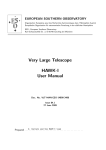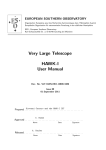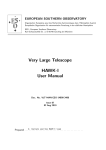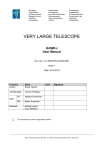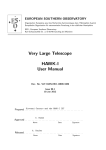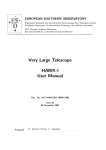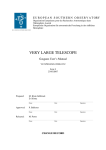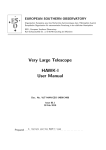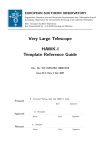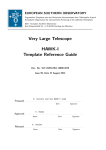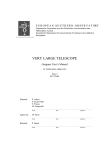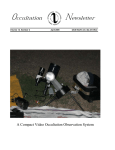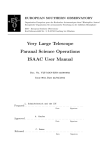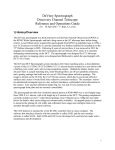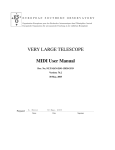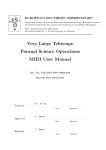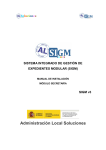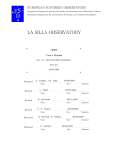Download HAWK-I User Manual
Transcript
EUROPEAN SOUTHERN OBSERVATORY Organisation Européene pour des Recherches Astronomiques dans l’Hémisphère Austral Europäische Organisation für astronomische Forschung in der südlichen Hemisphäre ESO - European Southern Observatory Karl-Schwarzschild Str. 2, D-85748 Garching bei München Very Large Telescope HAWK-I User Manual Doc. No. VLT-MAN-ESO-14800-3486 Issue 96 10 Jun 2015 Carraro and the HAWK-I IOT Prepared . Giovanni . . . . . . . . . . . . . . . . . . . . . . . . . . . . Approved C. Dumas . . . . . . . . . . . . . . . . . . . . . . . . . . . . . . . . . . . . . . . . . . Name Released . . . . . . . . . . . . . Date Signature A. Kaufer . . . . . . . . . . . . . . . . . . . . . . . . . . . . . . . . . . . . . . . . . . Name Date Signature HAWK-I User Manual Issue 96 Change Record Issue/Rev. Issue 1 Issue 81 Date Section/Parag. affected Issue 82 25 May 2007 all 31 August 2007 6 Dec. 2007 all 06 March 2008 Issue Issue Issue Issue Issue 82.1 82.2 83.0 83.1 84.0 06 March 2008 06 March 2008 01 Sep 2008 27 Nov 2008 29 May 2009 Issue Issue Issue Issue Issue Issue Issue Issue Issue Issue Issue Issue Issue Issue Issue Issue Issue Issue Issue 84.1 85.0 85.1 86.0 87.0 88.0 88.1 90.0 90.1 91.0 91.1 91.2 92.0 93.0 94.0 94.1 95 96 96 27 Jun 2009 09 Dec 2009 28 Feb 2010 30 Jun 2010 02 Aug 2010 05 Feb 2011 10 June 2011 18 Feb 2012 17 Jun 2012 06 Sep 2012 04 Oct 2012 04 Dec 2012 01 Mar 2013 06 Jan 2014 28 Jan 2014 07 Jun 2014 27 Aug 2014 22 Jan 2015 10 Jun 2015 Reason/Initiation/Documents/Remarks First release for PAE prepared for CfP P81 update after end of commissioning P82 Phase I version bump. Bug in overhead table corrected. Minor changes to introduction. minor bug Added warning about sky-subtraction. P83 Phase 1. cal plan. P83 addenda for the IP83 release. P84 addenda: New read-out mode and persistence study.Change of offset scheme. P84 addenda: cleaning and Phase II. P85 Phase I and II. Fast Photometry included. Several correction in the Appendix F. No changes from P86 to P87. Many different small changes. Many different small changes once again. No changes from P88 to P90. Updates for P90 Phase II. Updates for P91 Phase I and II. Fast Photometry section heavily updated. Update of several broken links. No news. Fast Photometry update USD comments implemented Corrected several typos. Added a figure. No news. Add a description of Adapter defocusing. Add reference to the GUCT, to the ETC seeing/IQ, USD comments implemented, fix broken links ii HAWK-I User Manual Issue 96 HAWK-I as a CAD drawing attached to the VLT and in the integration hall in Garching HAWK-I in a Nutshell Online information on HAWK-I can be found on the instrument web pages and in Kissler-Patig et al. 2008, A&A 491, 941. HAWK-I is a near-infrared (0.85 − 2.5 µm) wide-field imager. The instrument is cryogenic (120 K, detectors at 75 K) and has a full reflective design. The light passes four mirrors and two filter wheels before hitting a mosaic of four Hawaii 2RG 2048×2048 pixels detectors. The final F-ratio is F/4.36 (100 on the sky correspond to 169.4µm). The field of view (FoV) on the sky is 7.50 ×7.50 (with a small cross-shaped gap of ∼ 1500 between the four detectors). The pixel scale is 0.10600 /pix . The two filter wheels of six positions each host ten filters: Y, J, H, Ks (identical to the VISTA filters), as well as 6 narrow band filters (Brγ, CH4, H2 and four cosmological filters at 0.984, 1.061, 1.187, and 2.090 µm). Typical limiting magnitudes (S/N=5 in 3600s on source) are around J= 23.9, H= 22.5 and Ks = 22.3 mag (Vega). iii HAWK-I User Manual Issue 96 iv . . . . 1 1 1 1 1 Contents 1 Introduction 1.1 Scope of this document . . 1.2 Structure of this document 1.3 Glossary . . . . . . . . . . 1.4 Abbreviations and Acronyms I . . . . . . . . . . . . . . . . . . . . . . . . . . . . . . . . . . . . . . . . . . . . . . . . . . . . . . . . . . . . . . . . . . . . . . . . . . . . . . . . . . . . . . . . . . . . . . . . . . . . . . . . . . . . . . . . Observing with HAWK-I: from phase 1 to data reduction 2 PHASE 1: applying for observing time with HAWK-I 2.1 Is HAWK-I the right instrument for your project? . . . 2.1.1 Field of View . . . . . . . . . . . . . . . . . . 2.1.2 Filters . . . . . . . . . . . . . . . . . . . . . 2.1.3 Limiting magnitudes . . . . . . . . . . . . . . 2.1.4 Adapter defocussing . . . . . . . . . . . . . . 2.1.5 Instrument’s performance . . . . . . . . . . . 2.2 Photometry with HAWK-I . . . . . . . . . . . . . . . 2.2.1 Two ways to get reasonable photometry . . . 2.2.2 Consider the 2MASS calibration fields . . . . . 2.2.3 HAWK-I extinction coefficients . . . . . . . . 2.3 The Exposure Time Calculator . . . . . . . . . . . . 2.4 Proposal Form . . . . . . . . . . . . . . . . . . . . . 2.5 Overheads and Calibration Plan . . . . . . . . . . . . 3 PHASE 2: Preparing your HAWK-I observations 3.1 HAWK-I specifics to templates, OBs, and p2pp . 3.1.1 p2pp . . . . . . . . . . . . . . . . . . . 3.1.2 Observing Blocks – OBs . . . . . . . . . 3.1.3 Templates . . . . . . . . . . . . . . . . 3.2 Finding Charts and README Files . . . . . . . . . . . . 4 Observing (Strategies) with HAWK-I 4.1 Overview . . . . . . . . . . . . . . . . . . . . . . 4.2 Visitor Mode Operations . . . . . . . . . . . . . . 4.3 The influence of the Moon . . . . . . . . . . . . . 4.4 Twilight . . . . . . . . . . . . . . . . . . . . . . 4.5 Orientation, offset conventions and definitions . . 4.6 Instrument and telescope overheads . . . . . . . . 4.7 Recommended DIT/NDIT and Object–Sky pattern . . . . . . . . . . . . . . . . . . . . . . . . . . . . . . . . . . . . . . . . . . . . . . . . . . . . . . . . . . . . . . . . . . . . . . . . . . . . . . . . . . . . . . . . . . . . . . . . . . . . . . . . . . . . . . . . . . . . . . . . . . . . . . . . . . . . . . . . . . . . . . . . . . . . . . . . . . . . . . . . . . . . . . . . . . . . . . . . . . . . . . . . . . . . . . . . . . . . . . . . . . . . . . . . . . . . . . . . . . . . . . . . . . . . . . . . . . . . . . . . . . . . . . . . . 2 . . . . . . . . . . . . . . . . . . . . . . . . . . . . . . . . . . . . . . . . . . . . . . . . . . . . . . . . . . . . . . . . . . . . . . . . . . . . . . . . . . . . . . . . . . . . . . . . . . . . . . . . . . . . . . . . . . . . . . . . . . . . . . . . . . . . . . . . . . 2 2 2 3 3 4 4 4 4 5 5 5 6 6 . . . . . 8 8 8 8 8 9 . . . . . . . 11 11 11 11 11 12 13 13 HAWK-I User Manual II Issue 96 v Reference Material 16 A The HAWK-I filters 16 B The B.1 B.2 B.3 HAWK-I detectors Threshold-limited integration . . . . . . . . . . . . . . . . . . . . . . . . . . . . Detectors’ structures and features . . . . . . . . . . . . . . . . . . . . . . . . . . Detectors’ relative sensitivity . . . . . . . . . . . . . . . . . . . . . . . . . . . . . 19 20 20 22 C The HAWK-I Field-of-View C.1 Relative position of the four quadrants . . . . . . . . . . . . . . . . . . . . . . . C.1.1 Center of Rotation and Centre of Pointing . . . . . . . . . . . . . . . . . C.2 Vignetting of the field-of-view . . . . . . . . . . . . . . . . . . . . . . . . . . . . 25 25 25 26 D The D.1 D.2 D.3 27 27 27 27 HAWK-I calibration plan Do you need special calibrations? . . . . . . . . . . . . . . . . . . . . . . . . . . The HAWK-I standard calibrations in a nutshell . . . . . . . . . . . . . . . . . . . Quality Control . . . . . . . . . . . . . . . . . . . . . . . . . . . . . . . . . . . . E The HAWK-I pipeline 29 F HAWK-I Burst and Fast Jitter Modes F.1 Description . . . . . . . . . . . . . . . . . . . . . . . . . . . F.2 Implementation . . . . . . . . . . . . . . . . . . . . . . . . F.2.1 Detector Windowing . . . . . . . . . . . . . . . . . . F.2.2 Data Products and Cube Sizes . . . . . . . . . . . . F.2.3 Minimum DIT, Overheads, and Frame Losses . . . . . F.3 Preparation and Observation . . . . . . . . . . . . . . . . . . F.3.1 OB Naming Convention . . . . . . . . . . . . . . . . F.3.2 OB Requirements and Finding Charts . . . . . . . . . F.3.3 Observing Modes . . . . . . . . . . . . . . . . . . . F.3.4 Calibration Plan . . . . . . . . . . . . . . . . . . . . F.3.5 FITS Files Names . . . . . . . . . . . . . . . . . . . F.4 Template Guide . . . . . . . . . . . . . . . . . . . . . . . . F.4.1 Acquisition: HAWKI img acq FastPhot . . . . . . . . F.4.2 Science template: HAWKI img obs FastPhot . . . . . F.4.3 Calibration templates: HAWKI img cal DarksFastPhot 30 30 31 32 33 36 38 38 38 38 39 39 39 39 41 41 . . . . . . . . . . . . . . . . . . . . . . . . . . . . . . . . . . . . . . . . . . . . . . . . . . . . . . . . . . . . . . . . . . . . . . . . . . . . . . . . . . . . . . . . . . . . . . . . . . . . . . . . . . . . . . . . . . . . . . . . . . . . . . . . . . . . . . . . . . . . . . . . . . . . . . . . . . . . . . . . . . . . . HAWK-I User Manual 1 1.1 Issue 96 1 Introduction Scope of this document The HAWK-I user manual provides the information required for the proposal preparation (phase 1), the phase 2 observation preparation and the observation phase. The instrument has started regular operations in period 81. We welcome any comments and suggestions on the manual; these should be addressed to our user support group at [email protected]. 1.2 Structure of this document The document is structured in 2 parts. Part 1 (I) takes you step by step through the essentials (writing your proposal in phase 1, preparing your observations in phase 2, conducting your observations at the telescope and reducing your data). Part 2 (II) contains collected useful reference material. 1.3 Glossary 1.4 Abbreviations and Acronyms DMO ESO ETC FC FoV FWHM HAWK-I NIR OB P2PP PSF QC RTC RTD SM TIO USD VLT VM DIT NDIT Data Management and Operations Division European Southern Observatory Exposure Time Calculator Finding Chart Field of View Full Width at Half Maximum High Acuity Wide-field K-band Imager Near InfraRed Observing Block Phase II Proposal Preparation Point Spread Function Quality Control Real Time Computer Real Time Display Service Mode Telescope and Instrument Operator User Support Department Very Large Telescope Visitor Mode Detector Integration Time Number of Detector Integration Time HAWK-I User Manual Issue 96 2 Part I Observing with HAWK-I: from phase 1 to data reduction 2 PHASE 1: applying for observing time with HAWK-I This section will help you to decide whether HAWK-I is the right instrument for your scientific projects, take you through a quick evaluation of the observing time needed, and guide you through the particularities of HAWK-I in the proposal form. 2.1 Is HAWK-I the right instrument for your project? HAWK-I does only one thing, but does it well: direct imaging in the NIR (0.97 to 2.31 µm) over a large field (7.5’×7.5’). So far HAWK-I has been successfully used to study the properties of medium redshift galaxy clusters (see e.g. Lidman et al. 2008, A&A 489,981), outer solar system bodies (Snodgrass et al. 2010, A&A 511, 72), the very high redshift universe (Castellano et al. 2010, A&A 511, 20), and exo-planets ( Gillon et al. 2009, A&A 506, 359). The recent implementation of Fast Photometry (see Appendix F) is probably going to boost more activity in the exo-planets field. The basic characteristics (FoV, pixel scale, ...) can be found in the nutshell at the beginning of this document. 2.1.1 Field of View The FoV of HAWK-I is defined by four Hawaii-2RG chips of 20482 pixels each (1 pixel corresponds to 0.106” on the sky). The detectors are separated by gaps of about 15”. Thus, the FoV looks like this: 15” 217” 7.5’ HAWK-I User Manual Issue 96 3 Note that it is very tempting to point right onto your favourite target and to loose it in the gap, since this is where the telescope points. BEWARE of the gap between the detectors! And see the details in Appendix C. 2.1.2 Filters HAWK-I is equipped with 10 filters: 4 broad band filters, and 6 narrow band filters. (see appendix A for detailed characteristics and the URL to download the filter curves in electronic form). The broad-band filters are the classical NIR filters: Y,J,H,Ks. The particularity of HAWK-I is that the broad band filter set has been ordered together with the ones of VISTA. There are thus identical which allows easy cross-calibrations and comparisons. The narrow band filters include 3 cosmological filters: for Lyα at z of 7.7 and 8.7 (1.19µm, 1.06µm, respectively), for Hα at z = 2.2 (2.09µm), and as well as 3 stellar filters: CH4 , H2 , Brγ. Can you bring your own filters? Possibly. HAWK-I hosts large (105mm2 , i.e. expensive) filters, and was designed to have an easy access to the filter wheel. However, to exchange filters the instrument needs to be warmed up which, usually, only happens once per year. Thus, in exceptional cases, i.e. for very particular scientific program, user supplied filters can be installed in HAWK-I, within the operational constraints of the observatory. Please make sure to contact [email protected] WELL before buying your filters. The detailed procedure is described in a document available upon request (please email to [email protected]). 2.1.3 Limiting magnitudes Limiting magnitudes are of course very much dependent on the observing conditions. The exposure time calculator (ETC) is reasonably well calibrated and we encourage you to use it. In order to give you a rough idea of the performance to be expected, we list here the limiting magnitudes (S/N=5 for a point source in 3600s integration on source) under average conditions (0.8” seeing, 1.2 airmass): Filter J H Ks Limiting mag [Vega] 23.9 22.5 22.3 Limiting mag [AB] 24.8 23.9 24.2 Saturation limit (in 2 sec)∗ 10.0 10.3 9.2 *: assumed 0.8” seeing. For more detailed exposure time calculation, in particular for narrow band filters, please use the exposure time calculator. As for persistence on HAWKI detectors, the following rules apply. When using DITs smaller than 30 secs, persistence effects can be neglected. However, when using larger DITs the maximum accepted saturation is 7 times the HAWKI saturation level. Therefore, users are recommended to check carefully their fields against saturation using HAWKI ETC during Phase II and, in case, submit a waiver, which will be evaluated on individual case basis. HAWK-I User Manual 2.1.4 Issue 96 4 Adapter defocussing As of Period 96 it is possible to defocus the HAWK-I adapter to aloo observations of bright stars avoiding saturation. We expect this feature to be used mostly for transit/occultation observations. The defocussing is controlled by the keyword SEQ.ADA.FOCUS, which allows to set different focus value in mm (the default being 2.0). Please be aware that this is not the telescope focus. 2.1.5 Instrument’s performance We expect HAWK-I to be used for plain imaging, (fast)-photometry and astrometry. The image quality of HAWK-I is excellent across the entire field of view. Distortions are below 2% over the full 10’ diagonal and the image quality has always been limited by the seeing (our best recorded images had FWHM below 2.2 pix, i.e. <0.23” in the Ks band). The photometric accuracy and homogeneity that we measured across one quadrant is <5% (as monitored on 2MASS calibration fields). We expect that with an even more careful illumination correction and flat-fielding about 3% absolute accuracy across the entire field will be achieved routinely when the calibration database is filled and stable. Of course, differential photometry can be pushed to a higher accuracy. Note in particular, that given the HAWK-I field size, between 10 and 100 useful 2MASS stars (calibrated to 0.05 − 0.10 mag) are usually present in the field. Finally, the relative astrometry across the entire field is auto-calibrated on a monthly basis (see HAWKI calibration plan), using a sample of globular clusters as references. The distortion map currently allows to recover relative position across the entire field with a precision of ∼. 1 arc-sec A note of caution: as all current infrared arrays, the HAWK-I detectors suffer of persistence at the level of 10−3 – 10−4 (depending on how badly the pixels were saturated) that decays slowly over minutes (about 5min for the maximum tolerated saturation level in SM). This might leave artifacts reflecting the dither pattern around saturated stars. 2.2 Photometry with HAWK-I As you will have noticed, acquiring a single star per night does not allow to carry out high precision photometry, but rather to monitor the instrument performance, and make a rough evaluation of the quality of the night. 2.2.1 Two ways to get reasonable photometry If good photometry is your goal, you should go for one of the following options. • Ask for special calibrations! Take into account as early as phase 1 (i.e. in your proposal) the fact that you want to observe more and other standard fields than the ones foreseen in the calibration plan. In your README file you can then explain that you want your specified standard field observed e.g. before and after your science OB. HAWK-I User Manual Issue 96 5 You can also specify that you want illumination maps for your filters close in time to your observations, and/or specify as special calibrations your own illumination maps. • If a photometric calibration to ∼0.05–0.1 magnitude is enough for your program, consider that the HAWK-I field is large and that (by experience) you will have 10–100 stars from the 2MASS catalog in your field. These are typically cataloged with a photometry good to <0.1 mag and would allow to determine the zero point on your image to ∼ 0.05 mag, using these ”local secondary standards”. Extinction coefficients would automatically be taken into account. They are measured on a monthly basis. Besides, we remind that colour terms for HAWK-I are small, ∼0.1×(J-K). Check with Skycat (or Gaia) ahead of time whether good (non-saturated!) 2MASS stars are present in your science field. Skycat is available under http://archive.eso.org/skycat/ Gaia is part of the starlink project: http://starlink.jach.hawaii.edu/ 2.2.2 Consider the 2MASS calibration fields The 2MASS mission used a number of calibration fields for the survey. Details are given at http://www.ipac.caltech.edu/2mass/releases/allsky/doc/seca4 1.html In particular the sect.III, 2 http://www.ipac.caltech.edu/2mass/releases/allsky/doc/sec3 2d.html provides a list of fields (touch-stone fields) that you could use as photometric fields in order to calibrate your observations. 2.2.3 HAWK-I extinction coefficients We measured HAWK-I extinction coefficient for the broad-band filters as a result of a year monitoring. The results are: J = 0.043±0.005 H = 0.031±0.005 Ks = 0.068±0.009 Y = 0.021±0.007 We plan to keep monitoring these coefficients on a monthly basis, according to the calibration plan. 2.3 The Exposure Time Calculator The HAWK-I ETC can be found at: http://www.eso.org/observing/etc it returns a good estimation of the integration time (on source!) needed in order to achieve a given S/N, as a function of atmospheric conditions. A few words about various input variables that might not be quite standard (also read the online help provided on the ETC page): HAWK-I User Manual Issue 96 6 • As of P96, the seeing condition requested at Phase 1 no longer refers to the image quality at the observing wavelength but to the seeing in V-band at zenith. Such change has been reflected as well on the ETC, for which the seeing in V-band at zenith should be provided as seeing input parameter. • the parameters to be provided for the input target are standard. The input magnitude can be specified for a point source, for an extended source (in which case we compute an integration over the surface defined by the input diameter), or as surface brightness (in which case we compute values per pixel e.g. 106×106 mas). • Results are given as exposure time to achieve a given S/N or as S/N achieved in a given exposure time. In both cases, you are requested to input a typical DIT, which for broad band filters will be short (10 to 30s) but for narrow band filters could be long exposures between 60 and 300s before being sky background limited. • Do not hesitate to make use of the many graphical outputs. In particular for checking your target line (and the sky lines) in the NB filters... The screen output from the ETC will include the input parameters together with the calculated performance estimates. Here some additional notes about the ETC output values: • The expected image quality at the observing wavelength and requested airmass calculated from the seeing (V-band at zenith) input parameter. • The integration time is given on source: depending on your technique to obtain sky measurements (jitter? or offsets?), and accounting for overheads, the total observing time will be much larger. • The S/N is computed over various areas as a function of the source geometry (point source, extended source, surface brightness). Check carefully what was done in your case. Most of the other ETC parameters should be self-explaining and/or well explained in the online help of the ETC. 2.4 Proposal Form HAWK-I allows only 1 mode: direct Imaging. Please indicate which filters (in particular narrow-band filters) you intend to use. This will allow us to optimise their calibration during the semester. %\INSconfig{}{HAWK-I}{Imaging}{provide HERE list of filters(s) (Y,J,H,K,NB0984,NB1060,NB2090,H2,BrG,CH4)} 2.5 Overheads and Calibration Plan When applying for HAWK-I, do not forget to take into account all the overheads when computing the required time. • Make sure that you compute the exposure time including on sky time (not only on source) if your observing strategy requires it. HAWK-I User Manual Issue 96 7 • Verify in the call for proposal that you have taken into account all listed overheads; which can also be found in Sect. 4.6. To do so you can either refer to Sect. 4.5 or simulate the detailed breakdown of your program in terms of its constituent Observing Blocks (OBs) using the P2PP tutorial manual account (see Sect. 1.4 of P2PP user Manual). The Execution Time Report option offered by P2PP provides an accurate estimate of the time needed for the execution of each OB, including all necessary overheads. • Check whether you need any special calibration: have a look at the calibration plan in Sect. D – this is what the observatory will give you as default. You might need more, and we will be happy to provide you with more calibrations, if you tell us which. Note however that night calibrations should be accounted for by the user. Any additional calibration you might need should be mentioned in the phase 1 proposal and the corresponding (night) time to execute them must be included in the total time requested. HAWK-I User Manual 3 Issue 96 8 PHASE 2: Preparing your HAWK-I observations This sections provides a preliminary guide for the observation preparation for HAWK-I in phase 2, both for Service mode (SM) or Visitor mode (VM). We assume that you are familiar with the existing generic guidelines which can be found at: • http://www.eso.org/observing/observing.html Proposal preparation • http://www.eso.org/sci/observing/phase2/SMGuidelines.html informations • http://www.eso.org/paranal/sciops/VA_GeneralInfo.html Service mode VM informations We know that they are not super-thrilling, but a quick browse over them might save you some time during phase 2. 3.1 HAWK-I specifics to templates, OBs, and p2pp HAWK-I follows very closely the philosophy set by the ISAAC (short wavelength) and NACO imaging templates. 3.1.1 p2pp Using p2pp to prepare HAWK-I observations does not require any special functions (no file has to be attached except for the finding chart and possibly ephemerides, all other entries are typed). Step by step tutorial on how to prepare OBs for HAWK-I with P2PP can be found at the following link : http://www.eso.org/sci/observing/pahse2/SMGuidelines/Documentation/P2PPTutorialHAWKI.HAWKI.html . 3.1.2 Observing Blocks – OBs As an experienced ESO user, it will come as no surprise to you that any HAWK-I science OB should contain one acquisition template, followed by a number of science templates. If this did surprise you, you may need to get back to the basics. 3.1.3 Templates The HAWK-I templates are described in detail in the template reference guide available through the instrument web pages. A brief overview is given below. If you are familiar with the ISAAC SW imaging or NACO imaging templates, these will look very familiar to you and cover essentially the same functionalities. The acquisition and science templates are listed in Table 1. Two forms of acquisition exist: a simple preset (when a crude accuracy of a couple of arcsec is enough), and the possibility to interactively place the target in a given position on the detector. The science templates provide four forms of obtaining sky images: small jitter patterns for uncrowded fields; random sky-offsets for extended or crowded fields when the off-position needs to be HAWK-I User Manual Issue 96 9 acquired far from the target field; fixed sky-offsets when random sky-offsets are not suited; and finally the possibility to define an arbitrary offset pattern, when the standard strategies are not suited. For Rapid Response Mode we offer two acquisition templates. They are exactly the same as the normal acquisition template, but with the string RRM appended to the name. Table 1: Acquisition and science HAWK-I templates acquisition templates HAWKI img acq Preset HAWKI img acq MoveToPixel HAWKI img acq PresetRRM HAWKI img acq MoveToPixelRRM HAWKI img acq FastPhot science templates HAWKI img obs AutoJitter HAWKI img obs AutoJitterOffset HAWKI img obs FixedSkyOffset HAWKI img obs GenericOffset HAWKI img obs FastPhot functionality Simple telescope preset Interactive target acquisition Simple telescope preset for RRM Interactive target acquisition for RRM Acquisition for windowed mode comment recommended imaging imaging imaging imaging imaging recommended for low-density fields recommended for extended objects when random sky is not suited with with with with with jitter (no offsets) jitter and random sky offsets jitter and fixed sky offsets user defined offsets fast read out and windowing offered starting P82 offered starting P82 The calibration and technical templates are listed in Table 2. The only calibration template accessible to the SM user is the one to take standard stars. The calibration templates are foreseen to acquire darks, flat-fields and simple standard star observations to calibrate the zero point. The technical templates are used for the periodical characterisation of the instrument. The illumination frames are used to determine the variation of the zero point as a function of detector position. The astrometry and flexure templates are needed to compute the distortion map, the plate scale and relative positions of the detectors and to quantify possible flexures. Three further templates are used to characterise the detector, to determine the best telescope focus and to measure the reproducibility of the filter wheel positioning. Table 2: Calibration and technical HAWK-I templates calibration templates HAWKI img cal Darks HAWKI img acq TwPreset HAWKI img cal TwFlats HAWKI img cal SkyFlats HAWKI img cal StandardStar technical templates HAWKI img tec IlluFrame HAWKI img tec Astrometry HAWKI img tec Flexure HAWKI img tec DetLin HAWKI img tec Focus HAWKI img tec FilterWheel 3.2 functionality series of darks acquisition for flat-field imaging twilight flat-field imaging sky flat-field imaging of standard field comment available to the SM user imaging of illumination field imaging of astrometric field measuring instrument flexure/center of rotation detector test/monitoring telescope focus determination filter wheel positioning accuracy Finding Charts and README Files In addition to the general instructions on finding charts (FC) and README files that are available at: HAWK-I User Manual Issue 96 10 http://www.eso.org/sci/observing/phase2/SMGuidelines/FindingCharts.html, and, http://www.eso.org/sci/observing/phase2/SMGuidelines/ReadmeFile.generic.html, respectively. the following HAWK-I specifics are recommended: • The FoV of all FCs must be 100 by 100 in size, with a clear indication of the field orientation. • Ideally, the FC should show the field in the NIR, or at least in the red, and the wavelength of the image must be specified in the FC and the README file. • The (IR) magnitude of the brightest star in the field must be specified in the P2PP comment field of the OB. • The FC should show the position of the target at the end of the acquisition template. We encourage HAWK-I observers to use the new unified Guide Cam Tool (GUCT) that allows to prepare FCs that are compliant with the ESO general and instrument specific requirements. The tool and its manual are available for download at the following link: http://www.eso.org/sci/observing/phase2/SMGuidelines/GUCT.HAWKI.html HAWK-I User Manual 4 4.1 Issue 96 11 Observing (Strategies) with HAWK-I Overview As with all other ESO instruments, users prepare their observations with the p2pp software. Acquisitions, observations and calibrations are coded via templates and OBs. OBs contain all the information necessary for the execution of an observing sequence. At the telescope, OBs are executed by the instrument operator. HAWK-I and the telescope are setup according to the contents of the OB. The HAWK-I Real Time Display (RTD) is used to view the raw frames. During acquisition sequences, the RTD can be used as well as for the interactive centring of the targets in the field. Calibrations including DARKs, sky-flats, photometric standard stars, illumination maps etc are acquired by the Observatory staff according to the calibration plan and monitored by the Quality Control group of ESO Garching. 4.2 Visitor Mode Operations Information/policy on the Visitor Mode operations at the VLT are described at: http://www.eso.org/paranal/sciops/VA_GeneralInfo.html Visitors should be aware that about 30 minutes/night (of night time!) may be taken off their time, in order to perform the HAWK-I calibrations according to the calibration plan. In Visitor mode is also possible to observe bright objects using BADAO, say switching active optics off, although the newly implemented adapter defocussing (offered both in Visitor and Service mode, see 2.1.4) should be the preferred strategy to avoid the saturation of very bright target. Telescope defocussing is however not permitted. 4.3 The influence of the Moon Moonlight does not noticeably increase the background in the NIR, so there is no need to request dark or grey time. However, it is recommended not to observe targets closer than 30 deg to the Moon to avoid problems linked to the telescope guiding/active optics system. The effect is difficult to predict and to quantify as it depends on too many parameters. Just changing the guide star often solves the problem. Visitors should check their target positions with respect to the Moon at the time of their scheduled observations (e.g. with the tools available at http://www.eso.org/sci/observing/tools.html). Backup targets are recommended whenever possible, and you are encouraged to contact ESO in case of severe conflict (i.e. when the distance to the Moon is smaller than 30 deg). 4.4 Twilight Because HAWK-I is an infrared imager, observations of bright objects may be carried out in twilight. From P91 onwards, there is a new constraint in P2PP called twilight constraint. This constraint can be used to define the earliest time with respect to the end of the astronomical twilight when the execution of the OB can be started. While the relation between the time difference from the HAWK-I User Manual Issue 96 12 evening twilight end and sun elevation varies during the year, for Paranal due to its low latitude this difference is small. Therefore the constraint is given in minutes as a difference in time with respect to the end of astronomical twilight (i.e. the time when the solar elevation is -18 degrees). The default value of twilight constraint is -30. A negative number means that it is allowed to start the observation before the end of the astronomical twilight. The twilight constraint can take values between -45 and 0 minutes. 4.5 Orientation, offset conventions and definitions HAWK-I follows the standard astronomical offset conventions and definitions: North is up and East to the left. All offsets are given as telescope offsets (i.e. your target moves exactly the other way) in arc-seconds. The reference system can be chosen to be the sky (offsets 1 and 2 refer to offsets in Alpha and Delta respectively, independently of the instrument orientation on the sky) or the Detector (offsets 1 and 2 refer to the detector +X and +Y axis, respectively). For jitter pattern and small offset, it is more intuitive to use the detector coordinates as you probably want to move the target on the detector, or place it on a different quadrant (in which case, do not forget the 15” gap!). The sky reference system is probably only useful when a fixed sky frame needs to be acquired with respect to the pointing. For a position angle of 0, the reconstructed image on the RTD will show North up (+Y) and East left (–X). The positive position angle is defined from North to East (see Fig. 1). Figure 1: Definition of position angle. Note that the templates use always offsets relative to the previous pointing; not relative to the original position (i.e. each offset is measured with respect to the actual pointing). For example, if you want to place a target in a series of four offsets in the center of each quadrant: point to the star, then perform the offsets (-115,-115) [telescope moves to the lower right, star appears in the upper left, i.e. in Q4]; (230, 0); (0, 230); (-230, 0). Note that HAWK-I offers during execution a display that shows, at the start of a template, all the offsets to be performed (see below). It provides a quick visual check whether your pattern looks as expected (see Fig. 2): In the above example (Fig. 2) , 7 offsets are requested, and the way the are performed is shown in Fig. 3. The sequence of offset will be: (10,10), (90,-10),(-100,200), (100,-200), (-300,420) and (580,-10). HAWK-I User Manual Issue 96 13 Figure 2: Pop-up window at the start of an example template: it provides a quick check of your offset pattern 4.6 Instrument and telescope overheads The telescope and instrument overheads are summarised below. Hardware Item Paranal telescopes HAWK-I HAWK-I HAWK-I HAWK-I HAWK-I HAWK-I HAWK-I Action Time (minutes) Preset 6 Acquisition (*) Initial instrument setup (for ACQ only) 1 Telescope Offset (small) 0.15 Telescope Offset (large >90”) 0.75 Readout (per DIT) 0.03 After-exposure (per exposure) 0.13 Filter change 0.35 (*) The instrument set-up is usually absorbed in the telescope preset for a simple preset. In the case of ’MoveToPixel’, the exact integration time is dependent on the number of images one needs to take (at least 2) and of course the corresponding integration time. For 3 images of Detector Integration Time (DIT) =2 (NDIT=1), the overhead is 1.5min. 4.7 Recommended DIT/NDIT and Object–Sky pattern For DITs longer than 120sec, the SM user has to use one of the following DIT: 150, 180, 240, 300, 600 and 900sec. Table 3 lists the contribution of the sky background for a given filter and DIT. Please note that these values are indicative and can change due to sky variability especially for H band, whose flux for a given DIT can fluctuate by a factor of 2, due to variations of the atmospheric OH lines. This effect also impacts the Y, J & CH4 filters. The Moon has an effect on the sky background, HAWK-I User Manual Issue 96 14 Figure 3: Offset execution along the template. Table 3: Sky background contribution & Useful integration times Filter Contribution from sky RON limitation linearity limit Recommended DIT (electrons/sec) ∼DIT (sec) ∼DIT (sec) (sec) Broad band filters Ks 1600 <1 30 10 H 2900 <1 20 10 J 350 1.15 140 10 Y 130 3 400 30 Narrow band filters CH4 1200 <1 40 10 NB2090 60 7 900 60 NB1190 3.6 110 14000 300 NB0984 Visitor filter, now removed NB1060 3.4 120 14000 300 H2 140 17 400 30 BrG 180 15 300 30 especially for the NB1060 and NB1190 filters. Similarly the variation of the outside temperature impacts the sky contribution for the Ks , BrG, H2 and NB2090 filters. Due to the sky variations and in order to allow for proper sky subtraction, we recommend to offset at least every 2 minutes. Please be reminded that the minimum time at a position before an offset is about 1 minute. Figure 4 shows the quality of the sky subtraction as a function of pupil angle and time from the first frame. A sequence of frames in the Ks band was obtained when the target was near the zenith, and the pupil was rotating by 2.45 degrees/minute. Being the VLT an alt-azimuth telescope the image rotates with respect to the pupil. This is noticed as a rotation of the diffraction spikes seeing HAWK-I User Manual Issue 96 15 Figure 4: The annotation indicate the difference in pupil angle between the two frames being subtracted, and the difference in start time between the two exposures. around bright stars. The sky-subtraction error is larger when the pupil rotation angle between the two images is largest. HAWK-I User Manual Issue 96 16 Part II Reference Material A The HAWK-I filters The 10 filters in HAWK-I are listed in Table 4. The filter curves as ascii tables can be retrieved from the hawki instrument page. Note in particular that the Y band filter leaks and transmits 0.015% of the light between 2300 and 2500 nm. All other filters have no leaks (at the <0.01% level). Filter name Y J H Ks CH4 Brγ H2 NB0984 NB1060 NB1190 NB2090 Table 4: HAWK-I filter summary central cut-on cut-off width tansmission wavelength [nm] (50%) [nm] (50%) [nm] [nm] [%] 1021 970 1071 101 92% 1258 1181 1335 154 88% 1620 1476 1765 289 95% 2146 1984 2308 324 82% 1575 1519 1631 112 90% 2165 2150 2181 30 77% 2124 2109 2139 30 80% 983.7 981.2 986.2 5 60& 1061 1057 1066 9 70% 1186 1180 1192 12 75% 2095 2085 2105 20 81% comments LEAKS! 0.015% at 2300–2500 nm now removed Optical ghosts (out of focus images showing the M2 and telescope’spiders) have been rarely found only with the NB1060 (Lyα at z = 7.7) & NB1190 (Lyα at z = 8.7) filters. As illustrated in Fig. 5, the ghost images are 153 pixels in diameter and offset from the central star in the same direction; however the latter varies with each quadrant and is not symmetric to the centre of the moisac. The total integrated intensities of the ghosts are in both cases ∼ 2% but their surface brightnesses are a factor 10−4 of the peak brightness in the stellar PSF. The figure 6 summarizes the HAWK-I filters graphically. HAWK-I User Manual Issue 96 17 Figure 5: Smoothed enhanced images of the optical ghosts visible in the four quadrants for the NB1060 (left) & NB1190 (right) filters HAWK-I User Manual Issue 96 18 Figure 6: HAWK-I Filters. Black: broad-band filters Y, J, H, Ks , Green: cosmological filters NB1060, NB1190, NB2090; Red: CH4, H2; Blue: Brγ;magenta: visitor filter NB0984 HAWK-I User Manual B Issue 96 19 The HAWK-I detectors The naming convention for the four detectors is the following: Note that quadrant 1,2,3,4 are usually, but not necessarily, stored in extensions 1,2,4,3 of the HAWK-I FITS file. Indeed, FITS convention forbids to identify extensions by their location in the file. Instead, look for the FITS keyword EXTNAME in each extension and verify that you are handling the quadrant that you expect (eg. EXTNAME = ’CHIP1.INT1’). The characteristics of the four detectors are listed below: Detector Parameter Q1 Q2 Q3 Q4 Detector Chip # 66 78 79 88 Operating Temperature 75K, controlled to 1mK Gain [e− /ADU] 1.705 1.870 1.735 2.110 − Dark current (at 75 K) [e /s] between 0.10 and 0.15 Minimum DIT 1.6762 s 1 Read noise (NDR) ∼ 5 to 12 e− Linear range (1%) 60.000 e− (∼ 30.000 ADUs) Saturation level between 40.000 and 50.000 ADUs DET.SATLEVEL 25000 1 The noise in Non-Destructive Read (NDR) depends on the DIT: the detector is read continuously every ∼1.6762s, i.e the longer the DIT, the more reads are possible and the lower the RON. For the minimum DIT (1.6762s), the RON is ∼12e− ; for DIT=10s, the RON is ∼8e− and for DIT>15s, the RON remains stable at ∼5 e− . Figure 7 represents the quantum efficiency curve for each of the detectors. HAWK-I User Manual Issue 96 20 Figure 7: Quantum efficiency of the HAWK-I detectors B.1 Threshold-limited integration The normal mode of operation of the HAWK-I detectors defined a threshold by setting the keyword DET.SATLEVEL. All pixels which have absolute ADU values below this threshold are processed normally. Once pixels illuminated by a bright star have absolute ADU values above the threshold, the values are no longer used to calculate the slope of the regression fit. For these pixels only nondestructive readouts having values below the threshold are taken into account. The pixel values written into the FITS file is the value extrapolated to the integration time DIT and is calculated from the slope using only readouts below the threshold. The pixels that have been extrapolated can be identified because their values are above DET.SATLEVEL. B.2 Detectors’ structures and features We present some of HAWK-I’s detector features in two examples. Figure 8 is a typical long (> 60s) exposure. Some features have been highlighted: 1. some black features on chip 66 & 79 (Q1 and Q3). For both of them, when light falls directly on these spots some diffraction structures can be seen, as shown in the corresponding quadrants in Fig. 8 . HAWK-I User Manual Figure 8: Typical raw HAWK-I dark frame (DIT=300sec) Figure 9: Typical raw HAWK-I twilight flat field (Y Band) Issue 96 21 HAWK-I User Manual Issue 96 22 2. On the left (chip #88) there is an artefact on the detector’s surface layer. On the right (chip #79), these are sort of doughnut shaped features. More of these can be seen in Fig. 9 on chip #88. Both features are stable and removed completely by simple data reduction (no extra step needed). 3. Detector glow, which is visible for long DITs, but is removed by e.g. sky subtraction 4. The darker area visible in Fig 8 corresponds to the shadow of the baffling between the detectors. 5. Emitting structure, whose intensity grows with the integration time. It is however fully removed by classical data reduction. 6. Q4 chip#88 dark median has been found to be larger than the other detectors, and to increase with NDIT (see Fig. 10). Thanks to Sylvain Guieu for detecting this. 7. Q2 chip#78 suffers from radioactive effects (see Fig. 11 below) CHIP 1 CHIP 2 0.0 Dark median Dark median 8 −0.2 6 −0.4 4 −0.6 5 10 5 10 NDIT CHIP 4 NDIT CHIP 3 0.0 Dark median Dark median −0.6 −0.1 −0.8 −0.2 −1.0 −0.3 5 NDIT 10 5 10 NDIT Figure 10: Trend of dark with NDIT in the 4 detectors. B.3 Detectors’ relative sensitivity We undertook a program to assess the relative sensitivities of the four HAWK-I chips, using observations of the high galactic latitude field around the z=2.7 quasar B0002-422 at RA 00:04:45, HAWK-I User Manual Issue 96 23 Dec. -41:56:41 taken during technical time. The observations consist of four sets of 11 × 300 sec AutoJitter sequences using the NB1060 filter. The four sequences are rotated by 90 degrees in order that a given position on the sky is observed by each of the four chips of the HAWK-I detector. The jitter sequences are reduced following the standard two-pass background subtraction workflow described in the HAWK-I pipeline manual. Objects have been detected with the SExtractor software (courtesy of Gabriel Brammer), including a 0.9” gaussian convolution kernel roughly matched to the average seeing measured from the reduced images. Simple aperture photometry is measured within 1.8” diameter apertures. The resulting number counts as a function of aperture magnitude observed by each chip are shown in Fig. 12. As expected, the co-addition of the four jitter sequences reaches a factor of 2 (0.8 mag) deeper than do the individual sequences. The limiting magnitudes, here taken to be the magnitude where the number counts begin to decrease sharply and a proxy for the chip sensitivities, are remarkably similar between the four chips. We conclude that any sensitivity variations between the chips are within the 10%. While they do not appear to affect the overall sensitivity, the image artefacts on CHIP2 caused by radioactivity events (see Fig. 11) do result in an elevated number of spurious detections (dashed lines in Fig. 12) at faint magnitudes, reaching 20%at the limiting magnitude for this chip. The number of spurious detections in the other chips is negligible (see Fig 12). This rate of spurious detections on CHIP2 should be considered as a conservative upper limit, as it could likely be decreased by more careful optimisation of the object detection parameters. Figure 11: The field around the z=2.7 quasar B0002-422 as seen in the 4 HAWK-I quadrants. Radioactivity effects are clearly visible in Q 2 (chip #78) HAWK-I User Manual Issue 96 24 16 14 CHIP 1 CHIP 2 N mag−1 arcmin−2 12 10 8 CHIP 3 CHIP 4 Coadded stack 6 4 2 0 13 14 15 16 17 18 MAG APER (D = 1.800 , ZP = 25) 19 Figure 12: Number counts as a function of aperture magnitude for the four HAWK-I chips. The magnitudes as plotted adopt an arbitrary zero-point of 25 plus the relative zero-point offsets as monitored for the J filter (-0.14, +0.03, -0.23 mag for chips 2–4, relative to chip 1). The limiting magnitudes, i.e. the location of the turnover in the number counts, of the four chips are essentially identical within the measurement precision of this exercise (≤ 10%). Also shown are the number counts for a deep co-added stack of the four rotated and aligned jitter sequences. We use this deep image to assess the number of spurious sources detected on each chip: objects matched from the single chip image to the deeper image are considered to be real, while objects that only appear on the single-chip images are considered spurious. The number of spurious detections is negligible for chips 1, 3, and 4, though for chip 2 it reaches 20% around the limiting magnitude. HAWK-I User Manual C C.1 Issue 96 25 The HAWK-I Field-of-View Relative position of the four quadrants The four quadrants are very well aligned with respect to each other. Yet, small misalignments exist. They are sketched below: +157 +5 Q3 chip #79 Q4 chip #88 !=0.03o !=0.04o +142 +144 Q2 chip #78 Q1 chip #66 !=0.13o +3 +153 Quadrants 2,3,4 are tilted with respect to quadrant 1 by 0.13, 0.04, 0.03 degrees, respectively. Accordingly, the size of the gaps changes along the quadrant edges. The default orientation (PA=0 deg) is North along the +Y axis, East along the –X axis, for quadrant #1. For reference purposes, we use the (partly arbitrarily) common meta system: Quandrant Q1 Q2 Q3 Q4 offset in X (pix) offset in Y (pix) 0 0 2048 + 153 0+3 2048 + 157 2048 + 144 0+5 2048 + 142 It is valid in its crude form to within a few pixels. The distortion corrections for a proper astrometry will be added to all image headers. Distortions (including the obvious rotation component) will be defined with respect to the above system. First qualitative evaluations with respect to HST/ACS astrometric calibration fields recovered the relative positions of objects to about 5 mas once the distortion model was applied (a precision that should satisfy most purposes). C.1.1 Center of Rotation and Centre of Pointing The center of rotation of the instrument is not exactly the centre of the detector array. In the standard orientation (North is +Y, East is -X) the center of the detector will be located ∼0.4” East and ∼0.4” South of the telescope pointing. HAWK-I User Manual Issue 96 26 The common reference point for all four quadrants, taken as the centre of the telescope pointing and centre of rotation, has the following pixel coordinates (to ±0.5 pix) in the respective quadrant reference system: Quadrant Q1 Q2 Q3 Q4 CRPIX1 CRPIX2 2163 2164 -37.5 2161.5 -42 -28 2158 -25.5 The CRVAL1 and CRVAl2 have the on-sky coordinates of the telescope pointing (FITS keywords TEL.TARG.ALPHA , TEL.TARG.DELTA) in all quadrants. C.2 Vignetting of the field-of-view The Hawaii2RG detectors have 4 reference columns/rows around each device which are not sensitive to light. In addition, due to necessary baffling in the all-reflective optical design of HAWK-I, some vignetting at the edges of the field has turned out to be inevitable due to positioning tolerances of the light baffles. The measured vignetting during commissioning on the sky is summarised in the following table: Edge +Y –Y –X +X No of columns or rows vignetted > 10% Maximum vignetting 1 14% 8 54% 7 36% 2 15% The last column represents the maximum extinction of a vignetted pixel, i.e. the percentage of light absorbed in the pixel row or column, with respect to the mean of the field. Note : although the +Y edge vignetting is small in amplitude, it extends to around 40 pixels at < 10%. HAWK-I User Manual D D.1 Issue 96 27 The HAWK-I calibration plan Do you need special calibrations? The calibration plan defines the default calibrations obtained and archived for you by your friendly Paranal Science Operations team. The calibration plan is what you can rely on without asking for any special calibrations. However, these are indeed the only calibration that you can rely on without asking for special calibrations!! Thus, we strongly advise all the users to carefully think whether they will need additional calibrations and if so, to request them right in phase 1. For example: is flat-fielding very critical for your program, i.e. should we acquire more flats (e.g. in your narrow band filters)? Would you like to achieve a photometry better than a few percent, i.e. do you need photometric standards observe right before/after your science frames? Is the homogeneity of the photometry critical for your program - i.e. should you ask for illumination frames close to your observations? Is the astrometry critical, i.e. should we acquire a full set of distortion and flexure maps around your run? We would be more than happy to do all that for you if you tell us so ! (i.e. if you mention it in phase 1 when submitting your proposal). D.2 The HAWK-I standard calibrations in a nutshell Here is what we do, if we do not hear from you: HAWK-I – Calibration Plan Calibration Darks Darks Twilight Flat-fields number 10 exp. / DIT 5 exp. / DIT 1 set / filter 1 set / filter Zero points 1 set / (broad-band) filter Colour terms 1 set Extinction coefficients 1 set Detector characteritics 1 set frequency comments / purpose daily for DIT×NDIT ≤ 120 daily for DIT×NDIT > 120 daily broad-band filters (best effort basis) as needed for narrow-band filters daily UKIRT/MKO or Persson std monthly broad-band filters only (best effort basis) monthly broad-band filters only (best effort basis) monthly RON, dark current, linearity, ... Please do not hesitate to contact us ([email protected]) if you have any questions! D.3 Quality Control All calibrations taken within the context of the calibration plan are pipeline-processed and qualitycontrolled by the Quality Control group at ESO Garching. Calibration and science raw data are available through the ESO User Portal. More information about the HAWK-I quality control can be found under http://www.eso.org/observing/dfo/quality/HAWKI/qc/qc.html. The time HAWK-I User Manual Issue 96 28 evolution of the most important instrument parameters like DARK current, detector characteristics, photometric zero-points and others can be followed via the continuously updated trending plots available on the HAWK-I QC webpages (http://www.eso.org/observing/dfo/quality/ index$_$hawki.html). HAWK-I User Manual E Issue 96 29 The HAWK-I pipeline We refer to the pipeline manual for a full description on the HAWK-I pipeline. This section provides only a very brief overview of what to expect from the pipeline. The full link to the pipeline page is: http://www.eso.org/sci/software/pipelines/. The planned data reduction recipes included in the last delivery will be: • hawki img dark: The dark recipe produces master dark and bad pixel map. • hawki img flat: The flat-field recipe produces a master flat, a bad pixel map, a statistics table, the fit error image. • hawki img zpoint: This recipe provides the zero points for the UKIRT selected standards. • hawki img detlin: This recipe determines the detector linearity polynomial coefficients computation as well as the error on the fit. • hawki img illum: The illumination map of the detectors is obtained by observing a bright photometric standard consecutively at all predefined positions over a grid. • hawki img jitter: All science data resulting from the jitter and generic offset templates. The four quadrants are combined separately. The four combined products are eventually stitched together. However these stitched images are not meant for scientific usage. The online reduction pipeline, working on Paranal, will not provide this stitched image if min(offset)<1500 or max(offset)>1500”. Besides, utilities will be provided to make it easier for the users to reduce the data by hand, step by step. This utilities list is not finalised yet, but will contain among others: • hawki util distortion: Apply the distortion correction • hawki util stitch: Stiches 4 quadrant images together • hawki util stdstars: Generates the standard stars catalog from ascii files • hawki util gendist: Generates the distortion map used for the distortion correction HAWK-I User Manual F F.1 Issue 96 30 HAWK-I Burst and Fast Jitter Modes Description This section describes a mode for high-cadence and high time-resolution observations with HAWKI: the fraction of time spent integrating is typically ∼80% of the execution time, and the minimum DIT (MINDIT) is in the range ∼0.01-0.1 sec. The mode is useful in two observing scenarios: (i) studies of quickly varying sources that require good sampling of the light curves (i.e., X-ray sources); (ii) studies if events with limited duration that can’t be re-observed, so dead times are undesirable (i.e., transit timing variations of extrasolar planets). A good example of a combination of the two are Lunar occultations (Richichi et al. 20123, AJ, 146, 59). This is achieved by two measures: First, by windowing down the detectors to speed up the observations (in other words, to shorten the MINDIT) and to decrease the overheads for data transfer. For example, the MINDIT for a 64×64 px (∼6×6 arcsec) window, which is about a reasonable minimum for observing, is 0.1022 sec. Historically, the MINDIT was lower, but increased noise in the detectors led to slowing down the readout speed, and this increased it to the present value. Unfortunately, this effectively makes it impossible to carry out observational programs that require mili-seconds scale resolution. Archival users should be aware that initially (from 2010 to mid-2012) the mode suffered from extra overheads of 0.15 sec plus one MINDIT (the exact value depends on the detector windowing but for the most likely window sizes it is a few tens of a second or larger; an upper limit for a non-windowed detectors is MINDIT∼1.8 sec) associated with each DIT. This made observations with very high cadence requirements problematic but as of mid-2012 the new faster ReadRstRead detector readout mode, – described below, – was implemented. Note that the windows are not located at the center of the HAWKI field of view, i.e. if the telescope is preset to the target coordinates, the target will fall into the central gap between the four detectors. Therefore, one must calculate an offset, placing the target onto one of the detectors, preferably close to where the detector windows are. Second, the new detector readout mode ReadRstRead is used. It is similar to the Double Correlated where the sequence is: cycle 1: read the detector, reset the detector, read the detector, integrate for a time = DIT, sec cycle 2: read the detector, reset the detector, read the detector, integrate for a time = DIT, sec etc.. The frame is reconstructed by subtracting the second read of the first cycle from the first read of the second cycle, and so forth. The difference between the Double correlated and ReadRstRead modes is that when one pixel is reset or read, the rest of the pixels integrates; in case of the “normal” Double Correlated readout HAWK-I User Manual Issue 96 31 mode the pixel waits until all other pixels are reset/read which implies a read time of MINDIT for every DIT. ReadRstRead is therefore faster, since this waiting phase is absent and the overheads are of the order of a few microseconds per DIT–the time needed to reset/read only one individual pixel. The integrations of individual pixels in ReadRstRead mode are offset with respect to each other, so the integration of the last to be reset/read pixel starts MINDIT seconds after the integration of the first pixel to be reset/read. Usually, it is safe to ignore this effect–either because the DIT>>MINDIT (as is usually the case for exoplanet observations) or because the window is almost as small as the target size, so the signal from the target is averaged over nearly all pixels from the window (as is the case of the Lunar occultations). The mode has two modifications: (1) burst (NOT OFFERED!) is intended for applications that require short high time-resolution observations, i.e. lunar and KBO occultations, transits of extrasolar planets, etc; (2) Fast Jitter (OFFERED!) is intended for observations of extremely bright objects that require short DITs to avoid saturation, and small overheads, to increase the efficiency, i.e. exo-planet transits. The Burst mode is preferable when the DIT is equal or close to the minimum DIT because of the smaller frame loss and higher cadence due to skipping the image restoration from two detector reads. The penalty is the complicated structure of the output file (see below). The distinction between burst and Fast Jitter sub-modes was adopted for historical reasons - the previous instruments with fast imaging required significant additional overheads to reconstruct the images taking a difference of two detector reads. This is not the case for HAWKI, and therefore, only the Fast Jitter is offered. Update: The fast photometry may be familiar to the users of fast jitter and burst modes of ISAAC, NaCo, VISIR, and SofI. The main advantage of HAWK-I in comparison with these instruments is the wide field of view that allows a better selection of bright reference sources for relative photometry, and the favorable pixel scale. F.2 Implementation The Fast Photometry templates are discussed in details further, but for clarity we will point out here that they work in a markedly different way, with respect to the templates for other ESO instruments: the windowing parameters are present only in the acquisition template, and their values are carried over to the science template(s) by the Observing Software (OS) using designated common memory area. So, one can not skip the acquisition if it is necessary to modify the windowing parameters. If the acquisition is skipped, the science template will use the values from the last acquisition execution. If an OB has been aborted, the windowing parameters are remembered by the observing software (as long as the Detector Control System (DCS) and OS panels have not been reset/restarted), so the OB can simply be restarted, skipping the acquisition. Occasionally, during the execution of an OB a new acquisition image is not loaded automatically in the real-time display (RTD). In this case, one can re-load the last acquisition image in that RTD and re-draw the location of the windows by clicking on “set-up and draw” from the pop-up that BOB opens with the acquisition template. Important: a measure to reduce the load on the IRACE controller is to click on stop displaying the images on the RTD during the observations. This is achieved by pressing the Stop button on the RTD panel. NOTA BENE: The IRACE is set to default at the end, and this is critical for the observations HAWK-I User Manual Issue 96 32 afterwards. If an OB is aborted for some reason before this step, the IRACE remains in hardware windowing mode, with the window size defined during the OB, and with the store-in-data- cube mode ON. F.2.1 Detector Windowing For speeding up the observations the HAWK-I detectors are windowed at hardware level, so only the pixels that fall within the user-defined windows are actually read. In contrast, in case of software windowing the entire detectors are read, and only the pixel values within the user-defined windows are stored, so there is no gain in speed. The hardware windowing is hard-coded in the templates, and does not require any further action from the user. Each HAWK-I detector is read in 16 vertical stripes. The stripes span 128×2048 px, and each of the detectors spans 2048×2048 px. One window is defined in each stripe, but the locations of the windows are not independent, i.e. they all move together in a consistent manner that will be described further below. Therefore, the total number of windows for each HAWK-I frame is 4×16=64 because HAWK-I is a made of 4 detector arrays. Along the X-axis the windows can be contiguous or separated within each detector; even contiguous windows within the detector offer only sparse coverage on the sky because the four detectors themselves only offer a sparse coverage of the focal plane, i.e. there is space between the arrays (gaps) , so one can not have a single contiguous window across the entire focal plane. The situation closest to that are four contiguous windows–one across each of the four detectors. An additional constraint is that the windows must be centered within the stripes. Since the stripes are 128 pixels wide – an even number, – the width of the windows (defined by DET.WIN.STARTX, see below) must also be an even number. The detector windows are described by the following parameters: • DET.WIN.STARTX and DET.WIN.STARTY define the starting point of the window within an individual stripe. The X-axis on all detectors increases in the same direction, but the Y-axis on the upper and the lower detectors increases in opposite directions, so when the values of DET.WIN.STARTX and DET.WIN.STARTY increase, the starting points of the windows move to the right along the X-axis, and towards the central gap along the Y-axis. Note that these parameters are different at the software level from the parameters DET.WIN.STARTX and DET.WIN.STARTY used to define the windowing in other HAWK-I observing modes!! Values larger than 100 px are recommended for DET.WIN.STARTY because the background at the edges of the detectors is higher due to an amplifier glow. The allowed value ranges for DET.WIN.STARTX and DET.WIN.STARTY are 1...128 and 1...2048, respectively, but if they are set to 128 and 2048, the window will only be 1×1 px, so the users should select smaller starting values to leave room for an ample size of the windows. • DET.WIN.NX and DET.WIN.NY define the sizes in pixels of the windows in each individual stripe. For example, if the user wants to define a window of 18×28 px on each stripe, the corresponding values of DET.WIN.NX and DET.WIN.NY will be 18 and 28, respectively. These values will produce a fits file that contains a 3-dimensional data cube with 576×56×NDIT because of the 16 stripes in each of the two detectors along the X-axis (18×16×2=576) and the two detectors along the Y-axis (28×2=56). The allowed values are 1...128 and 1...2048 for DET.WIN.NX and DET.WIN.NY, respectively.t However, the users should take care that the starting point plus the size of the window HAWK-I User Manual Issue 96 33 along each axis do not exceed the size of the stripe along that axis: 128 or 2048, respectively for X and Y. Figure 13 shows examples of various detector window definitions. For instance, an increase of the parameter DET.WIN.STARTX would move the violet set of windows towards the yellow set, if the other parameters are kept fixed. Similarly, an increase of the parameter DET.WIN.STARTY would move the violet set towards the solid black set. The dashed black line set corresponds to DET.WIN.NX=128 (128×16 stripes ×2 detectors=4096 px in total along the X direction) that defines contiguous windows (see below). An interesting special case is to define contiguous regions (i.e. the windows on the individual stripes are as wide as the stripes themselves, so there are no gaps along the X-axis) - one has to use for example: DET.WIN.STARTX=1, DET.WIN.STARTY=48, DET.WIN.NX=128 and DET.WIN.NY=32, corresponding to windows on the stripes with sizes of 128×32 px (∼13.3×3.3 arc-secs), gives MINDIT=20 milli-secs. Note that the stripes are 128 px wide, so this is indeed a contiguous region on each of the detectors, with size 2048×32 px (∼217.7×3.4 arcsec). Typically, the choice of window sizes is the result of a compromise between a few conflicting requirements: • faster photometry (i.e., smaller overheads, smaller MINDIT, higher time resolution), requires smaller window sizes; • more accurate photometry (i.e., brighter and more reference stars, wider clear area to measure the sky level, wider margin for human errors during the acquisition, leeway for target drift across the window because of poor auto-guiding or atmospheric refraction since the target is observed in the NIR, and the guiding is in the optical) requires wider window sizes; • smaller data volume requires smaller windows; • higher data cadence (i.e., less gaps between files for transfer, fits header merging) requires smaller window. To simplify and standardize the observations, and to minimize the day-time calibration time, the following constraints on the window parameters are imposed: • Only contiguous windows that span entirely the width of the detectors are offered, so DET.WIN.NX must always be set to 128 (∼13.3 arcsec), and DET.WIN.STARTX – to 1. Therefore, the total size of the output file along the X axis is always 128×32=4096 pixels. • Only three values for the window height are allowed, so DET.WIN.NY can be set to 32, 64 or 128 pixels (∼3.3, 6.7 or 13.3 arc-seca, respectively). There is no restriction on where the windows are located, so the users are free to set DET.WIN.STARTY to any possible value (from 1 to 2048−DET.WIN.NY). If the scientific goals of the program require different window sizes, the users must contact the User Support Department to check if they are technically feasible/acceptable, and if this is the case – to ask for a waiver. F.2.2 Data Products and Cube Sizes The data product is a fits file containing cubes with slices made from the tiled-together images of all windows (windows in each stripe), i.e. spliced together without the gaps that will be present HAWK-I User Manual Issue 96 34 Figure 13: Definition of the windows. The location of the four HAWK-I detectors on the focal plane is shown, as well as the 16 stripes in which each detector is being read. The sizes of the detectors and the gaps, projected on the sky in arc-secs are also given. The binaries generated from quadrants 1, 2, 3, and 4 are usually (but not always) stored in fits extensions 1, 2, 4, and 3. Arrows indicate the direction in which the parameters DET.WIN.STARTX, DET.WIN.STARTY, DET.WIN.NX and DET.WIN.NY increase. Note, that the parameter DET.WIN.STARTX defines the starting point of the window, counted from the beginning of each detector stripe, not from the beginning of the detector. All these parameters are defined in pixels, although this figure is plotted in arc-secs. As examples, four different sets of windows are shown in violet, yellow, solid and dashed black lines. HAWK-I User Manual Issue 96 35 between the individual windows (such gap occur always because of the gaps between the detectors; extra gaps occur if DET.WIN.NX is smaller than 128 and if DET.WIN.NY is smaller than 2048). The Burst sub-mode (describe here below only for historic reasons and to highlight the differences with jitter mode) generates a single fits file, containing a single cube; the FastJitt generates as many files (each containing a cube) as the number of the jitters in the OB. The cubes contain one extra slice (i.e. NDIT+1 instead of NDIT) because the last slice is the average of all NDITs. In Fast Jitter mode, the sliced in the generated cubes are: 1st DIT (a difference between the 2 reads, separated by DIT seconds) 2nd DIT (a difference between the 2 reads, separated by DIT seconds) ... INT (an averaged frame of all previous slices) Therefore, if no frames are lost, the generated cube contains: N AXIS3 = N DIT + 1 (1) slices. In Burst mode, the slices in the generated cubes are: 2nd read of 0th DIT (not an actually useful integration) 1st read of 1st DIT (the first useful integration begins), 2nd read of 1st DIT (the first useful integration ends), 1st read of 2nd DIT (the second useful integration begins), ... 2nd read of NDIT-th DIT (the last, NDIT-th useful integration ends), 1st read of NDIT-th + 1 DIT (not an actually useful integration begins) INT (an averaged frame) Therefore, if no frames are lost, the generated cube contains: N AXIS3 = 2 × (N DIT + 1) + 1slices. (2) Frame loss, that plagues some other “fast” instruments, has not been noticed during the typical applications of the HAWK-I fast photometry modes. Most likely, because of the slowing down of the detector read speed, that increased the minimum DITs. This problem usually occurs when the product of NX and NY is relatively large, and DIT is close to MINDIT, so the IRACE has to transfer large data volume quickly. To check for frame losses, verify that NAXIS3 header keyword is equal to estimates, given above. A “feature” of unknown nature causes a loss of two frames in the first cube after changing the Burst from True to False. It is recommended to take a short bust after such a change, before starting the actual science observations. The HAWK-I fast mode is subject to a maximum cube limitation, similarly to ISAAC and SofI. The buffer size in this case is 512 Mb. If the cube size exceeds the 512 Mb limit, the observations will be split into multiple file extensions, but the headers of all extensions will contain the DATA-OBS information for the start of the observation, not for the start of the given extension. Each extension will also have its own smaller header. This poses a problem if the aim of the program is to achieve high timing accuracy because the data transfer time and the fits header merging time are subject to variations depending on the load on the local network and on the instrument workstation. These HAWK-I User Manual Issue 96 36 variations are hard to quantify, so we recommend to keep the cube size below 512 Mb. In addition, the overheads are larger if the cube is split into individual files, because they have to be merged, so an extra time to copy the entire cube into a single file is necessary. Finally, the OS supports a maximum size of 2 Gb, and if the combined size exceeds that, the merging fails, and the OB is aborted. Therefore, the NDIT must be limited to keep the file size below 512 Mb. The user has two options to adjust the cube size: • to change the window size defined by DET.WIN.NX , or • to change the number of slices in the cube defined by NDIT. Often the former is not possible, because the size is set by other considerations, i.e. the angular separation on the sky between a target and a reference source, the required low MINDIT or the need to have large enough window to avoid slit-like losses (especially in case of poor seeing). Therefore, reducing the NDIT may be the only solution to this problem. The cube size for FastJitt mode (that stores restored images) is: (N X ∗ 32) ∗ (N Y ∗ 2) ∗ N DIT ∗ 4 ≥ (512 × 1024 × 1024) = 536870912 (3) The maximum acceptable NDIT is: N DITmax ≤ (536870912/((N X ∗ 32) ∗ (N Y ∗ 2) ∗ 4)) − 1 (4) The “−1” leaves space for the averaged image, that is always stored in the last slice of the cube. The Burst mode stores separately the two reads that form each images, so, for the same NDIT it generates twice more data than the FastJitt mode. Therefore, in Burst mode the maximum NDIT is half of that for the FastJitt mode. F.2.3 Minimum DIT, Overheads, and Frame Losses The MINDIT depends strongly on the size and weakly on the location of detector windows. The MINDITs and the execution times for some of the offered windowing parameter combinations are listed in Table 5. The table shows that the overheads depend mainly on the window size (because of the amount of pixels that need to be read and transferred) while the location of the window has minor effects. The “faster” windows are located close to the outer edges of the detectors, i.e. with smaller values of STARTY. However, it is recommended to avoid setting STARTY=1 px, because the edges of the detectors usually suffer from stronger cosmetic defects. The experience shows that these effects are smaller starting from STARTY=100-150 px. The time spent on the acquisition is a matter of how many fine adjustments are needed. The absolute minimum of the acquisition, without any telescope movement, or movement of instrument wheel, is ∼100 sec. This is important to remember in case of aborting and restarting the OB with acquisition. Therefore, if the OB has to be aborted for some reason, and there is no need to make adjustments, it is better to skip the acquisition template. Table 5 also shows the execution times for a few extreme or typical cases: if the DIT is set to the smallest available value for a given windowing configurations, and if the DIT is set to 0.1-0.2 secs, which are often requested by the users. HAWK-I User Manual Issue 96 37 Table 5: Timing Parameters. The execution times were rounded to 1 sec. The overheads are given for executing NEXP = 5 exposures, in stare mode (i.e., with jitter box size JITTER.WIDTH = 0 and NOFFSET = 1). The 32 and 2 multiplication factors are given to remind the user that the NX and NY parameters are the total width of the detector windows across the entire set of stripes. The readout mode is ReadRstRead. STX and STY stand for STARTX and STARTY, respectively. (*): this is a non standard case! STX px NX px 1 32×32=1024 (*) 1 128×32=4096 1 128×32=4096 1 128×32=4096 1 128×32=4096 1 128×32=4096 1 128×32=4096 1 128×32=4096 1 128×32=4096 1 128×32=4096 1 128×32=4096 1 128×32=4096 1 128×32=4096 STY px NY px 1 1 1 1 1 1 1 1024 1024 1024 2016 1984 1920 32×2= 64 32×2= 64 32×2= 64 32×2= 64 32×2= 64 64×2=128 128×2=256 32×2= 64 64×2=128 128×2=256 32×2= 64 64×2=128 128×2=256 MINDIT Max. DIT NDIT Integr. Exec.Times sec NDIT sec Time 1 exp. NEXP=5 sec sec sec 0.051096 511 0.051096 511 26.110056 28 160 0.051864 511 0.051864 511 26.502504 28 165 0.051864 511 0.1 511 51.1 53 286 0.051864 511 0.2 511 102.2 104 542 0.051864 511 0.2 128 25.6 28 159 0.1037 255 0.1037 255 26.4435 28 164 0.2074 127 0.2074 127 26.3398 28 166 0.066186 511 0.066186 511 33.821046 35 199 0.1180 255 0.1180 255 30.0900 32 181 0.2217 127 0.2217 127 28.1559 30 176 0.080074 511 0.080074 511 40.917814 43 236 0.1315 255 0.1315 255 33.5325 36 200 0.2342 127 0.2342 127 29.7434 32 182 Frame loss % 1.2 7.2 1.3 2.4 1.0 4.6 11.2 3.4 4.4 7.6 2.6 3.4 2.0 For convenience, we list the integration time for a single data cube (equal to NDIT×DIT), the execution time for a single cube, and the execution time for a template that generates five cubes (NEXP=5). The test were carried out with NJITT=1, JITTER.BOX=0, the Read-speed factor was 8, and the Read-speed add was 0. The last two parameters are low-level detector controller parameters, they are controlled by the observing templates, and they are fixed at these values for technical reasons beyond the scope of this document; we list them here just for completeness. The filter for the observations was set up in the acquisition template; if it must be changed in the science template, there will be additional overheads related to the filter movement. The overhead per template is typically ∼30-33 sec. Let’s consider the last case in the table: five exposures of NDIT×DIT=29.7434 sec collect together 148.717 sec of integration, leaving 33 sec in overheads, up to the template execution time of 182 sec. These ∼33 sec are build up as follows: ∼2 sec to process the template and to send a set up command to the instrument – this could be much longer if there is a filter change; ∼10 sec to set up the IRACE detector controller, ∼2-3 sec to transfer every data cube and to merge the fits file and its header, ∼10 sec to set up the IRACE detector controller back to the “standard” set up at the end of the template. A detailed time line of the execution is shown in Table 6. The overheads listed above may vary by 1-2 sec. Finally, the HAWKI Fast Photometry mode suffers from frame loss, especially if the DIT is close to the the MINDIT for the given windowing configuration. Table 5 lists the frame loss rate in percentages. The frame losses increase with the size of the window, and for a given window size they decrease with increasing DIT, as can be seen from the few examples for NX=128, NY=32. Last bit not least, the frame losses depend on the network load: the experience shows that just turning off the RTD during the observations can reduce the frame loss by 2-3%. Unfortunately, HAWK-I User Manual Issue 96 38 Table 6: Example Timing Parameters of the last case considered in Table 5. Action start template IRACE set up start exposure 1 end exposure 1 start exposure 2 end exposure 2 start exposure 3 end exposure 3 start exposure 4 end exposure 4 start exposure 5 end exposure 5 IRACE set up end template Time 21:04:38 21:04:40 21:04:50 21:05:22 21:05:22 21:05:54 21:05:54 21:06:26 21:06:26 21:06:58 21:06:58 21:07:30 21:07:40 21:07:40 other loads on the network can not be controlled by the operators, which can easily leads to uncertainty in the frame loss rate of 2-3%, as our experiments has shown. Frame losses for the window sizes listed in the Table 5 practically disappear for DIT=0.5–1.0 sec. F.3 F.3.1 Preparation and Observation OB Naming Convention Following the common convention for the fast modes: FastJitter OBs (BURST=F) should start with the prefix “FAST” in their name, F.3.2 OB Requirements and Finding Charts The finding chart requirements are the same as for the other VLT instruments. The typical accuracy of the VLT pointings is below 1 arcsec. However, the simple preset HAWKI img acq Preset can not define the correct detector windowing for the fast mode! The windowing is defined only in the specialized acquisition template it HAWKI img acq FastPhot. Therefore, HAWKI img acq FastPhot must be executed at least once, and the windowing parameters should be kept the same during the entire sequence. Sec. F.4. F.3.3 Observing Modes The Burst mode is not offered anymore, while the FastJitter mode is now offered both in Service and Visitor mode. HAWK-I User Manual F.3.4 Issue 96 39 Calibration Plan • Darks taken with the same windowing and readout mode, • Twilight Flats, non-windowed and with the same filters as the science observations are offered, the users only have to excise from them the necessary windows; we compared windowed and non-windowed KS flats, and found no significant difference (Fig. 14). F.3.5 FITS Files Names The file names for the fast mode contain “FAST” for clarity. The extensions SAMPLE and DIT are also appended to the FITS file name. F.4 F.4.1 Template Guide Acquisition: HAWKI img acq FastPhot The detector windowing parameters (DET.WIN.STARTX, DET.WIN.STARTY, DET.WIN.NX and DET.WIN.NY) are defined in this template. They are used to draw on the RTD the locations of the 32 windows. These parameters are stored in OS registers, and used by the science template later. They can be accessed by the science template even if it has been aborted and restarted multiple times, as long as the OS has not been stopped and restarted. The action sequence performed by the template includes: 1. Preset the telescope, set up the instrument (no windowing at this stage, the full field of view is shown on the RTD). 2. Move to the sky position, take a non-windowed image, ask the operator to save it in the RTD and to turn on the sky subtraction 3. Take a non-windowed image of the field of view, ask the operator if an adjustment is necessary. Note that the adjustment here includes both the telescope pointing (and field of view orientation), and the detector windowing parameters. At this stage the operator is expected to press the “draw” button that draws on the RTD the windowing as defined in the acquisition template. The operator can modify it at any time from now on (by typing numbers on the pop up window), but has to redraw to have the latest version shown on the RTD. 4. If the operator gives a negative answer, the template acquires an image, saves it, and then ends. Otherwise, an offset window is opened on the RTD to let the operator to define an offset and rotator angle offset (and to modify the windowing parameters). 5. The offsets (including the rotator offset) are sent to the telescope and after they are executed, the template returns to item 3 where it takes another non-windowed image and so on. HAWK-I User Manual Issue 96 40 Figure 14: Histograms of the ratios between a windowed and two non-windowed KS twilight flats. For comparison, the ratio of the two non-windowed flats and a Gaussian function is also shown. HAWK-I User Manual F.4.2 Issue 96 41 Science template: HAWKI img obs FastPhot This template is similar to the ISAACLW img obs FastPhot except that it takes the detector windowing parameters from the OS registers, so these parameters can’t be modified from within HAWKI img obs FastPhot. The template operates in two modes: Burst and FastJitter. In Burst mode the telescope is staring at the target for the duration of the integration (INT=NDIT×DIT) and only one data cube is produced. In FastJitter mode, the telescope can jitter in the sky and many data cubes (one per offset) can be produced within one template. Action sequence performed by the template is identical to that of the HAWKI img obs AutoJitter template: 1. Sets up the instrument, including selection hardware detector windowing. 2. Performs a random offset (most users are likely to set the jitter box size to zero to keep the objects located on the same pixels, which should reduce systematic effects from imperfect flat fielding. 3. Acquires images stored in a cube, and continues as long as the number of the frames in the cube is equal to the value of the parameter DET.NDIT (this parameter defines the length of the cube). The number of cubes acquired at each offset position is defined by SEQ.NUMEXP. 4. Goes back to step and repeats the actions until SEQ.NUMOFFSET offsets are executed. Specific details: • The new windowing parameters (DET.WIN.STARTX, DET.WIN.STARTY, DET.WIN.NX and DET.WIN.NY) are not accessible to the user from this template. • The parameter DET.BURST.MODE selected between Burst (True) and Fast Jitter (False) modes. • Readout mode is set to DoubleRdRstRd because for now this is the only one for which the new windowing is implemented. • The hardware windowing is set to True (implicitly for the user). • The store-in-cube option is set to True. F.4.3 Calibration templates: HAWKI img cal DarksFastPhot Twilight flats for this mode are obtained with the normal non-windowing HAWKI img cal TwFlats template making the dark current calibration template HAWKI img cal DarksFastPhot the only unique calibration template for the fast mode. It is similar to the usual dark current template HAWKI img cal Darks, with the execution of the hardware windowing and the storage of the data in cubes. The parameters for filter, DIT, and NDIT are lists, allowing to obtain multiple darks in one go. Specific details: HAWK-I User Manual Issue 96 42 • The new windowing parameters (DET.WIN.STARTX, DET.WIN.STARTY, DET.WIN.NX and DET.WIN.NY) define the detector windowing. As in the science template, they are used to window the detectors but unlike the science template they are explicitly definable and accessible by the users. • The previous parameters are not available in the calibration templates. All the calibration are taken as reconstructed images, in other words DET.BURST.MODE is internally always set to False. • Readout mode is set in the template implicitly to Double RdRstRd because for now this is the only one for which the new windowing is implemented. • The hardware windowing is set to True. • The store-in-cube option is set to True.















































